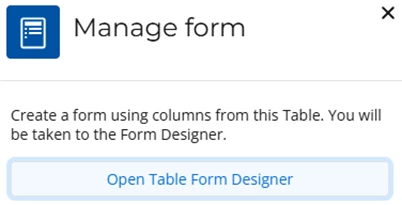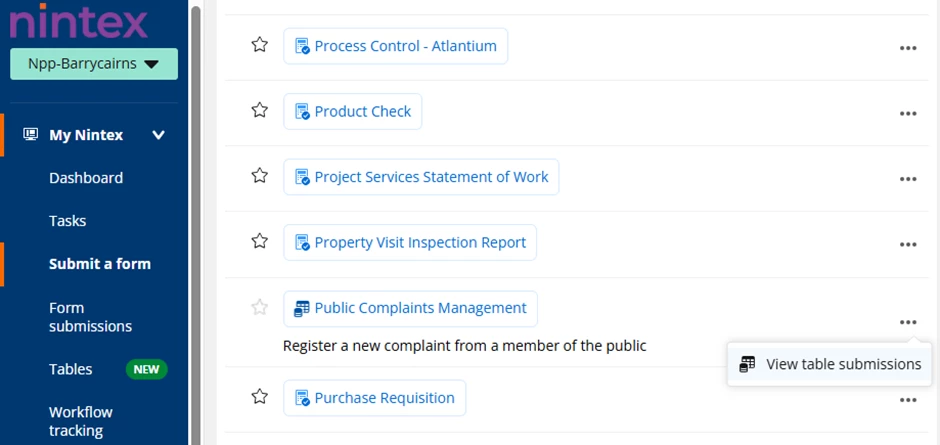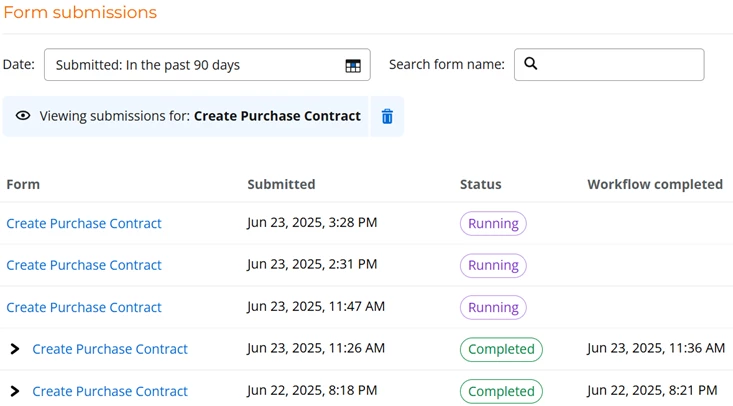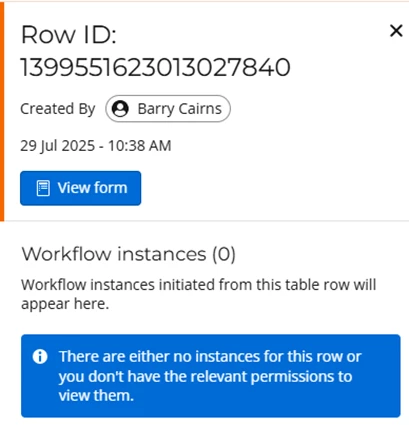Feature Deep Dive: Table forms in Nintex Workflow
Video: 1-minute intro to Nintex Workflow table forms.
Background:
In June 2024 Nintex released Data (aka Tables) into general availability in Nintex Workflow following a 6-month Beta period. Nintex Data for the first time allowed workflow designers to consider storing business data inside the NW platform rather than relying on an external data store…common examples of those being SharePoint or databases. Alongside Data, workflow actions were added to allow management of rows of data. It is fair to say that to date, table data has sat squarely in the domain of the workflow designer, unless visualised elsewhere in e.g. Nintex Apps.
What’s Changed?
In July 2025 Releases 1 & 2, Nintex has added significant new functionality on top of Nintex Data tables that greatly enhances their scope of use and addresses some common asks in Nintex Workflow CE.
That functionality has been further added to in October 2025 release 1, most notably with anonymous table forms.
List of Table Features in October 2025 Release
- Anonymous table forms
- Table data filters – display only rows that match specific criteria
List of Table Features in July 2025 Releases
- Table Start Events in Workflow
- Increased Table limits – now accommodating up to 200,000 rows per table
- The subject of this post: Table Forms
- Design forms directly on top of a table using the familiar forms designer
- Use forms to save data directly to a table, without a related workflow
- Edit table data using either the table form or grid view
- Implement a new granular set of permissions to manage table access
- Promote tables to My Nintex (as opposed to only the designer area) allowing participant access to view and manage table data
From the above, there are a couple of standouts worth mentioning. First, the ability to build a form that does not need an associated workflow to create data is something that has been commonly requested in Nintex Workflow CE. There may be many scenarios where many submissions can be collected in a table and processed by workflow periodically, rather than a one form, one workflow approach.
Second, the ability to edit data on a previously submitted form is again something that many have asked for and can be supported without workarounds or taking the process into App Dev.
We know many of you work extensively in SharePoint and combine Nintex with that platform. SharePoint supports those two called out functions via list forms and we can now support that fully in standalone Nintex Workflow CE too. This is great news for customers considering upcoming deprecations in SharePoint and looking at modernisation initiatives!
Let’s Get into It!
For this example, I’ve created a Nintex data table that has a range of column types and several rows of sample data.
Form Designer
I can now access the Forms designer using the option in the top navigation of my table:


If you’ve built a start form for Nintex Workflow, you’ll be very familiar with what you see next. If you’ve built a Nintex Form on top of a SharePoint list, again, you’ll be conceptually familiar with what happens next. The Nintex Forms designer opens with the fields already added to the canvas connected to their respective columns.

Most features you will be familiar with from workflow start and task forms are also available for table forms including:
- Pages
- Assisted Language Translations
- Styles (basic & advanced CSS)
- Rules (form, page & submit)
- Form & Data Variables
In this case, I’ll stick to making some classic drag & drop layout changes and apply some Nintex purple styling to my form.

Having saved the form design, I can now separately publish the form against my table.

Much like when publishing an authenticated workflow start form, I can choose to make the form available in My Nintex for authenticated forms. And, based on the most recent release, I can now also make my form anonymously accessible by selecting the Anyone with the form URL option. If I select that option, I can copy the form URL and add the link to wherever I would like participants to fill the form e.g. in an email body, or via a link on my website.

When revisiting the form settings later the selected form access option is clearly displayed. If you need to change between authenticated and non-authenticated, re publish the form.

Accessing the Table Form
Let’s now look at the impact of having published the table form.
While I’m inside the table (via the Data menu option as a table designer) I can add a new item using the form using the Add button at the top of the table.

At the bottom of the table, two options are available: Add via form and Add via grid.

Remembering that we chose to publish the form to My Nintex let’s see the impact there.
Tables is now available in My Nintex and I can see any tables that I have access to work with (we’ll come back to permissions and roles shortly).

Upon selecting a table I have access to the same Add options as we saw above when accessing as a workflow designer / developer…but this is now also a participant function.
In addition, my table form is listed in the Submit a form section alongside all my workflow start forms and I can submit the form from here too. Furthermore, I can quickly navigate to view all submissions into that table.

Note that if the item listed under Submit a form is a workflow start form the menu label will read View form submissions and take you into a pre-filtered view of the form submissions section e.g.

Leading to…

We’ve heard in the past that the inability to edit data on a workflow start form can be problematic, particularly for those of you who may be used to taking advantage of that type of functionality in SharePoint based applications. While there have been workarounds for workflow, table forms now open up that possibility in a fully supported sense. We’ve seen adding data. But now we can also edit data in a table form. We can access this by:
Clicking the menu button at the left of each table row

Then clicking the View form button in the right-hand panel which appears

(Note the section above for Workflow instances. As you may know, we now have Tables as a native start event for Nintex Workflow, and this is how you could quickly view workflow instance information against a table data item).
Alternatively you can right click anywhere in the table row and select View form

Table Roles & Permissions
Back in the Automate tab and Data menu, we can set granular permissions for who can access table data in specific circumstances. Select the Automation permissions option under Permissions on the table settings menu.

The link above details the matrices of role versus permission clearly. From a functional perspective the key takeaways should be that:
- Both individuals and groups can be added to the membership of a role
- Roles permit the ability to grant access to read all rows in a table
- Roles permit the ability to grant access to edit all rows in a table
- Roles permit the ability to add a new row to a table but not access existing data
- Roles permit the ability to limit access to the add / edit data via the grid
- Roles permit the ability to limit a user’s access to table data to their created items only
Table Filters
The latest release of tables has introduced functionality to query table rows based on simple to advanced filters.
The filter option is located to the top right of every table.

Parameters can be added as multiple filters, and as filters within groups for more complex queries. A simple filter might look like:

And an example using Filter groups where I want to see all items where:
- The complaint type is Service Issue OR Product Issue OR
- The complaint type is Staff Behavior AND the status is not equal to Resolved

Where a filter is applied this is clearly indicated above the column heading and the filter can be quickly edited there too.

What’s Next?
Above we’ve seen what Nintex has done with the first releases of Table Forms. Suffice to say though there’s more to come soon for tables and forms including:
- Version history for table rows including support for previous value in workflow start events (i.e. compare current and previous value in workflow conditional start)
- Expanded support for table column types / form fields such as File Upload, People (picker) & Repeating Sections
- Advanced relationships between tables (one-many, many-many)
- AI Assistant for table forms design
- AI Assistant for table creation and populating sample data



